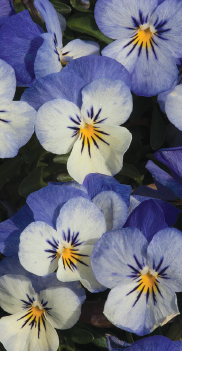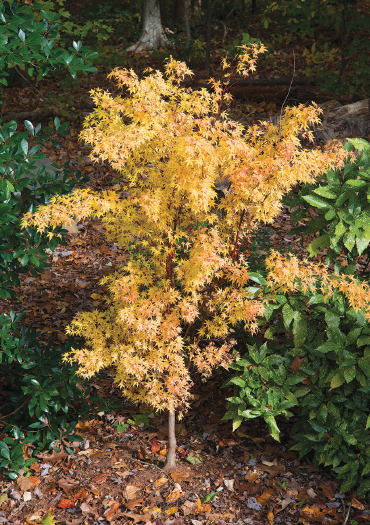Although ‘Sango Kaku’ is just one of many Japanese maple cultivars capable of adding their special beauty to landscape schemes in area gardens, there are five reasons why this particular pretty deserves a closer look.
First, it is a selection that is fairly easy to find at local nurseries. The remaining four reasons? The seasons.
No matter what time of year it is, ‘Sango Kaku’ draws attention to itself — yes, even in the dead of winter. Right now, in the dull, sullen landscapes of February, this Japanese maple is gleaming. True to its more common name, coral bark maple, it simmers in the chilled air with limbs that have brightened to a sizzling scarlet.
This is especially true of newer branches, as older limbs tend to fade over the years to a brownish-gray. However, judicious pruning of maturing branches every few years in the late winter helps prolong the parade of colorful young limbs, and also maintains a proper height for this small tree, which can reach upward to 20 feet.
Spring & summer
With the coming of spring, the neon-like sass of coral bark maple’s limbs begins to darken to a much less noticeable deep red. But ‘Sango Kaku’ still has the flair to flaunt. It celebrates the new growing season by unfolding young leaves dipped in an attractive yellowish-green hue lightly tinged in red on the margins.
This Japanese maple will also develop flowers in the springtime, but they are small, fleeting dots of reddish-purple that are best appreciated up close rather than from a distance.
Summer finds the leaves of ‘Sango Kaku’ fading to a light green, but their typical Japanese maple palmate form with five or more long, pointed lobes still makes them visually appealing. A mature coral bark maple will also usually have a handsome rounded vase-like shape, meaning it is a good choice to show off as a specimen planting or high-profile accent addition in a summer setting.
FIRE! That describes ‘Sango Kaku’ in the fall, with its leaves shaking out of their summer green slumber and igniting in a golden yellow glow. Such an autumn display is hard to miss, but if this Japanese maple is planted in front of an evergreen grouping of trees or shrubs, its bright botanical burn from the foliage will really pop.
Like many other Japanese maples, ‘Sango Kaku’ is tougher than it looks. This pretty tree is deer-resistant and does well in either urban or woodland gardens. It can be planted in the sun, which actually helps to intensify the limbs’ winter coral color, but a location slightly shaded from the worst of ol’ Sol’s afternoon rays in the summer will aid in preventing leaf scorch.
 Although it can stand a wide range of soil types, planting the coral bark maple in a well-worked, slightly acidic, mulched site will make it happier, and a happy ‘Sango Kaku’ is nothing short of four seasons worth of eye-candy!
Although it can stand a wide range of soil types, planting the coral bark maple in a well-worked, slightly acidic, mulched site will make it happier, and a happy ‘Sango Kaku’ is nothing short of four seasons worth of eye-candy!
L.A. Jackson is the former editor of Carolina Gardener Magazine. Want to ask L.A. a question about your garden? Contact him by email at
lajackson1@gmail.com.
To Do in the Garden
February
- Why wait ‘til spring to till? Break up the soil at the beginning of this month, and mix in beneficial amendments such as compost, lime or chopped up leaves.
- If voles and moles have been an unfortunate fact of life in your annual beds, while tilling up the soil, make their playground inhospitable by incorporating liberal amounts of pea gravel or, even better, PermaTill to give them a real rocky road to travel underground the next time they try to visit the garden.
- Summer woody ornamentals such as althea, butterfly bush, crepe myrtle, oleander, hydrangea and vitex flower on new wood, so now is a good time to prune to stimulate new springtime branches.
- Have any small trees or shrubs that were root pruned last fall in order to be moved? This month is a good time to dig ‘em up and relocate to their new home in the garden.
- If you love your fescue lawn, think of it on Valentine’s Day. That will be a good time to give it a nutrient boost of lawn fertilizer at a rate of one pound of nitrogen per 1,000 square feet to get it ready for the spring growing season.
- Before new growth begins on liriope, shear the plants to make room for the young shoots to come. Clippers will do the job in small beds, but for long border expanses, set the lawn mower up to its highest setting and do the deed in five minutes or less.
- Make sure your tools are ready for the spring growing season — sharpen any cutting tools you have, and change the oil and gas in any motorized garden helpers.
- The nesting activities of birds will be picking up soon, so clean out and repair bird houses. Also, provide your winged garden friends plenty of nutrients by keeping the bird feeder well stocked. And if the feeder gets soaked during a rain, clean out any wet seed, which could spoil or become moldy.
 Timely Tip
Timely Tip
Pansies are workhorses in winter flower beds, but with proper maintenance these annuals can keep on popping out their cheerful blooms deep into the spring.
First, make it a regular chore to pick off spent blossoms to make way for future flowers. Also, apply a diluted solution of liquid fertilizer every two to three weeks to encourage these pretty plants to continue their colorful bloom production.
For the next round of fall-planted pansies later this year, consider the many series of heat-tolerant cultivars such as “Maxim,” “Antique Shades,” “Majestic Giant” and “Universal,” which have been especially bred to easily extend their flower shows not only through the winter, but even into June.







